Comparison of SF6 Model Ages with Model Ages of Other Transient Tracers
The wells at Locust Grove have been sampled numerous times between 1990 and 1998 (Busenberg and Plummer, 2000). The early model ages of the ground water were based on CFC-11 and CFC-12 concentrations using the method of Busenberg and Plummer [1992]. These results were presented elsewhere [Dunkle et al., 1993; Plummer et al., 1993]. Recently, waters from these wells and some new wells were dated with three CFC’s (CFC-11, CFC-12, and CFC-113). The CFC-113 dating method was developed by the authors and has been extensively used by the U.S. Geological Survey to date waters in numerous studies [Busenberg and Plummer, 1993; Cook et al., 1995 and 1996; Katz et al., 1995; Szabo et al., 1996; Modica et al., 1998; Plummer et al., 1998; Plummer and Busenberg, 1999]. The date of sampling, and the model recharge ages of the ground waters using CFC’s, 3H/3He, 85Kr [Ekwurzel et al., 1994], SF6, and numerical simulation procedure [Reilly et al., 1994] are given in Busenberg and Plummer [2000]. The calculated recharge N2-Ar temperatures of 10.5 ± 1.3°C were calculated from the permanent gas composition of the ground waters. With the exception of two old samples, the volume of excess air present was between 0 and 3 cm3 STP/kg of water. Total He concentrations were measured by gas chromatography and increased with age of the ground water as shown below.
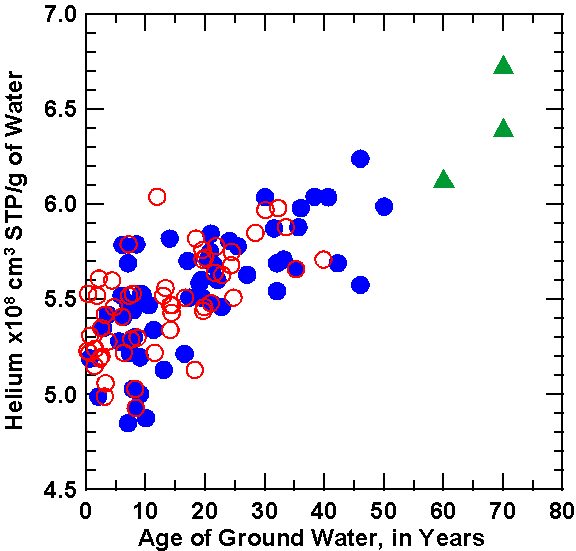
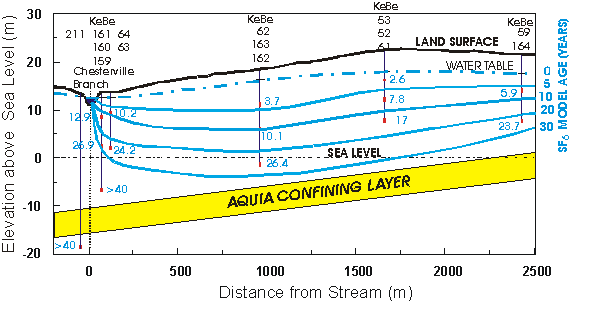
Cross section showing model SF6 ages of the ground water at Locust Grove, Maryland, U.S.
The differences between some of the apparent tracer ages are useful in providing clues to some of the processes occurring in the ground water at this site. The CFC-based ages older than those based on SF6 and numerical simulation at well KeBe 53 apparently resulted from the anaerobic biodegradation of CFC’s at or near the water table. The discrepancy between the SF6 and CFC results for the shallow wells KeBe 62 and KeBe 167 may result from the difficulty in dating waters that are less than 10 years old with CFC’s. This uncertainty results from the post–1990 rapid decrease in the atmospheric growth rate of CFC-12. The growth rate of CFC-12 slowed significantly in mid-1996 and has remained fairly steady since at less than 1 percent per year [Butler et al., 1998] as a result of the ban of the use of CFC’s in developed countries by the Montreal Protocol, therefore, it is possible to resolve only decadal age information in dating post-1993 ground water with CFC-11 and CFC-113 [Plummer and Busenberg, 1999]. Very close agreement was found between other transient tracers and CFC’s in the earlier sampling of the same wells [Dunkle et al., 1993; Ekwurzel et al., 1994; Busenberg and Plummer, 2000] when CFC concentrations were rapidly rising in the atmosphere. Even though CFC-12 concentrations are still increasing, the analytical error of 3 percent is significantly higher than the present yearly growth rate of about 0.5 percent per year. Local atmospheric anomalies as well as small uncertainty in the recharge temperature can cause significant error in the calculated model CFC-12 ages in post-1993 water. An advantage in the use of SF6 for dating young ground waters is the exponential rise of SF6 concentrations in the atmosphere, while CFC-11 and CFC-113 do not give unique ages in post-1993 ground water.
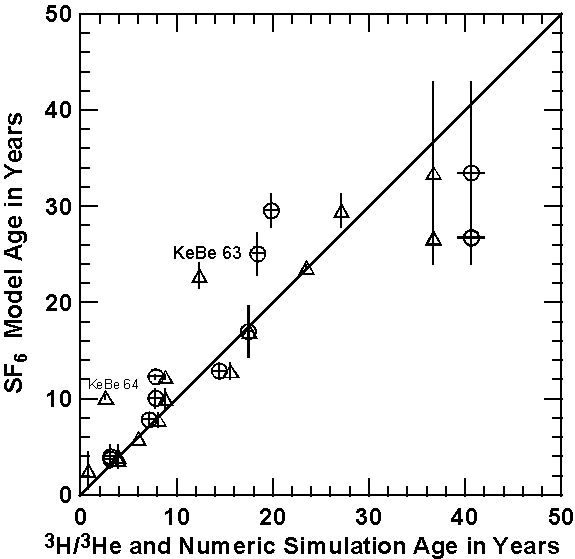
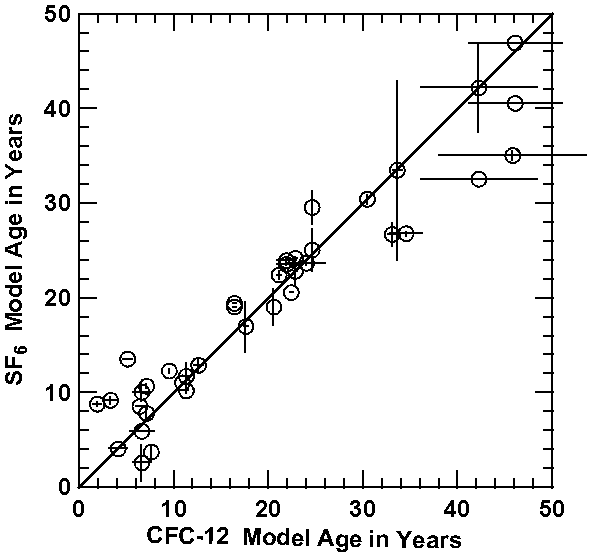
Locust Grove, Maryland
The Locust Grove watershed is located on the Delmarva Peninsula on the Atlantic Coastal Plain. The surficial aquifer is unconfined and consists of sands and gravels, and ranges in thickness from about 25 m at Chesterville Branch in the southern part of the watershed to about 5 m in the northern part. The surficial aquifer is underlain by the Aquia confining layer which consists mainly of silt and clay. Maps showing the geographic location, the location of wells, and the flow paths can be found in Dunkle et al. [1993], Reilly et al. [1994] and Böhlke and Denver [1995].
The area is intensely farmed; principal crops are corn, soybeans, and ornamental shrubs and trees. The ground-water chemistry has been profoundly altered by the agricultural practices [Hamilton and Shedlock, 1992; Hamilton et al., 1993, Böhlke and Denver, 1995]. The concentrations of agricultural chemicals in the ground water can be used to estimate the relative ages of the water at this site [Böhlke and Denver, 1995]. There is good correlation between age and nitrate concentration in the ground water, the results clearly reflect the recent increase in the use of fertilizers.
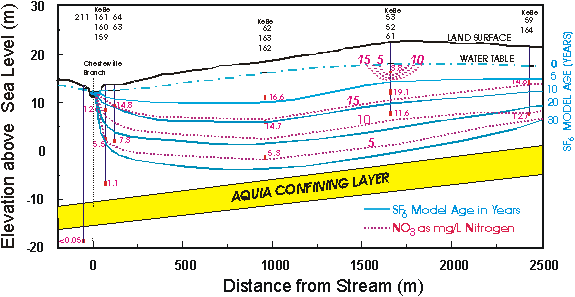
Cross section showing model SF6 ages and nitrate concentrations of the ground water at Locust Grove, Maryland, U.S.